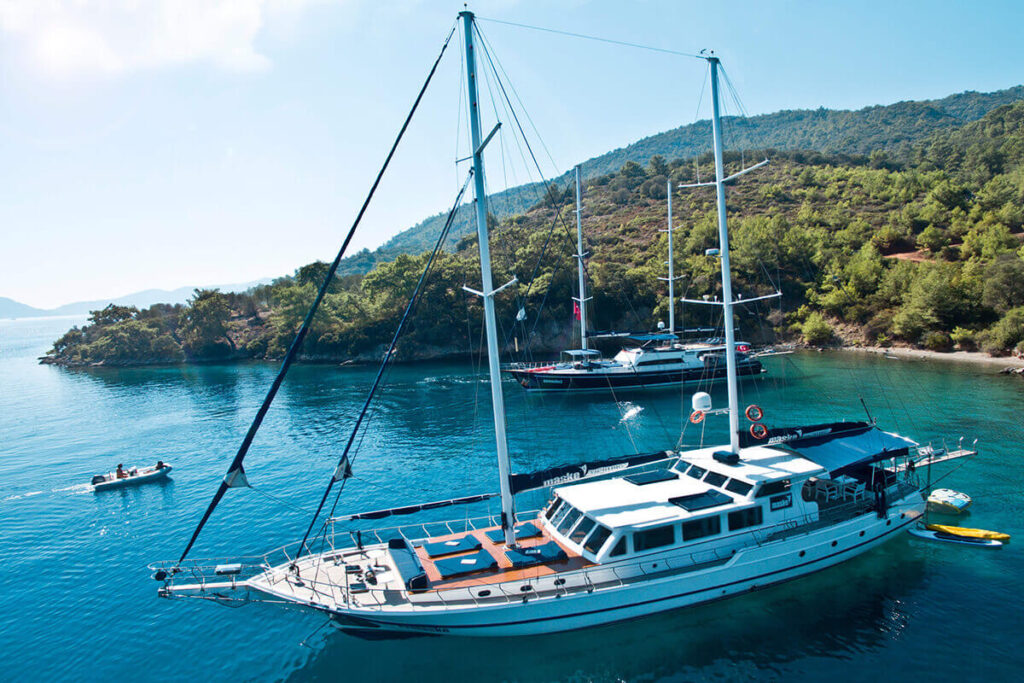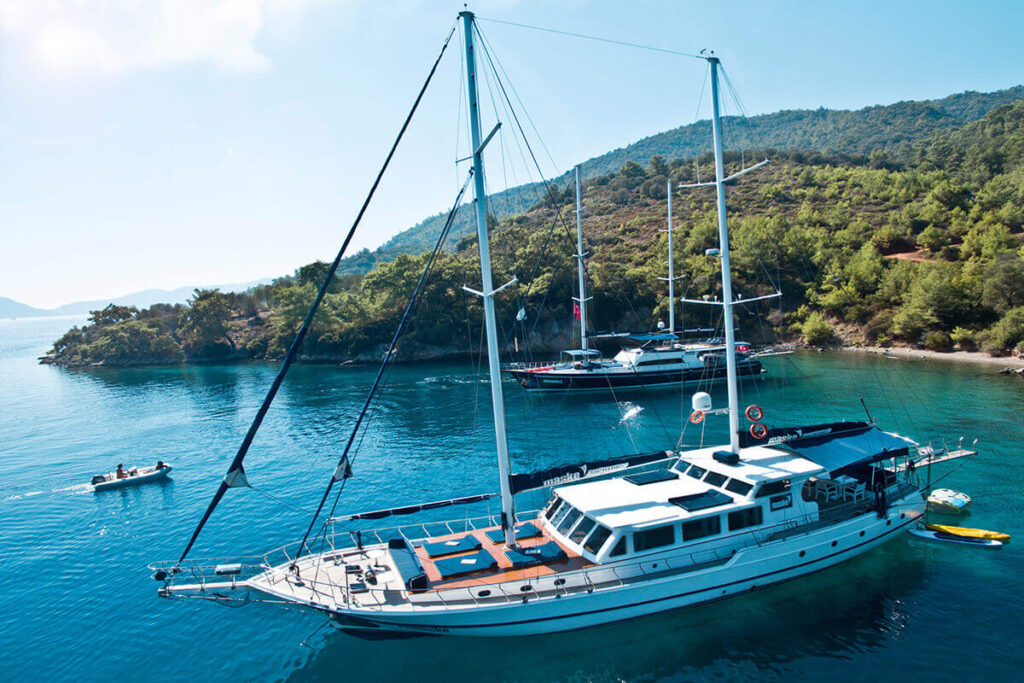What Is A Turkish Gulet?

- What is a gulet?
- Size of gulet
- Equipment of gulet
- Renting gulet
- The gulet in history
- The construction of a gulet
- The three different types of gulets
- Tirhandil in Turkish or trechenderi in Greek
- Gulet
- Ketch (aynakıç)

What is a Gulet?
“It is a yacht combining the charm of the old with the comfort of the new”…
The gulet is a beautiful traditional wooden boat that has its origins in a simple fishing boat and which has transformed over time into a majestic leisure boat.
A gulet is a charming residence that sails on the waves with onboard staff (3 or 4 navigation professionals) attentive to the well-being of holidaymakers on board.
Size of gulet
From 11 to 35 m in length for an average width of 5 to 8 m, there are different categories of gulet ranging from 2/3 stars (standard) to 5 stars (ultra-luxury). In the ports, their majestic lines are admired by all.
Equipment of gulet
The gulets are furnished with great taste and style to offer maximum comfort to passengers. Each cabin (from 2 to 18 depending on the size of the boat) is equipped with double or single beds, portholes, wardrobe, bathroom with shower/WC, and often air conditioning. Bed linen and shower towels are provided. Housekeeping is daily.
At the front, the deck is equipped with mattresses and cushions for sunbathing. At the back, you can relax in the shade of an awning on the vast beach with comfortable beds. A huge table will allow you to take all the meals served during the cruise (breakfasts, lunches, or dinners according to the chosen formula).
On board there is also a fully equipped kitchen where the chef will prepare tasty local dishes, an indoor lounge, a bar, and a sound system for music.
Depending on the gulet, a variety of equipment is offered: paddle, windsurfing, canoeing, traditional fishing, snorkeling, water-skiing, bicycles, board games, books, etc.
Wifi and television with DVD player can also be part of the equipment.
Gulets are equipped with sails but mainly sail under engine so that we are not dependent on winds to establish our route. The cruising speed is 9 knots (16 km/h), and the distances covered during the day are modest. We sail along the Aegean coasts and islands, the sailing conditions are ideal in this region. In any case, no worries, we do not have to worry about anything related to navigation.
The shallow draught allows us to access creeks that are uncrowded and still preserved. For swimming, we choose to descend either by a ladder located on the port or starboard side or, if we are more daring, to dive directly from the deck. A small tender boat allows us to be disembarked on the beaches or to practice water sports (only on the Luxury category). When mooring in the charming little ports, a footbridge at the rear of the boat gives access to the quay.
Renting gulet
The boat can be rented either in its entirety (with family or friends) or only in the cabin (we then share the gulet with vacationers who, like us, have chosen an alternative holiday in all simplicity and conviviality): prices are accessible to all and vary according to the chosen type of gulet and the taken route.
The gulet in history
Originally the gulet was light and narrow wooden boat that was used by fishermen and sponge divers on the Aegean and Mediterranean coasts, an economically significant activity from 1950 to 1980 in this region.
In the 1920s, the Turkish writer Cevat Sakir Kabaagaçli was sentenced to exile in Bodrum for an anti-militarist article. At that time, Bodrum was an isolated fishing village with its castle-prison reserved for expatriates. What was supposed to be purgatory soon turned into a real paradise for the writer. Having become friends with the sponge fishermen, he sails with them in the gulfs of the region and discovers the beauties of the Aegean coast. His novels echoed his new life and soon attracted the intellectuals of Istanbul. The voyages in gulets in the footsteps of the ancient peoples begin: this was the beginning of blue-cruise. Since the 1970s, the blue-cruise is no longer a leisure activity reserved for intellectuals; With the development of tourism, fishing boats are being transformed into leisure boats. Today, cruising has become a new holiday concept for sea and nature lovers.
Over the years, the gulets have been modernized and have become authentic floating hotels. Their originally tapered rear has been truncated to increase sleeping capacity.
The construction of a gulet
The majority of the gulets is built in Bodrum and its surroundings, about thirty famous shipyards can be found there as well as in Marmaris, Bozburun, Fethiye, Antalya, İstanbul or on the Turkish Black Sea coast.
Their construction is handmade by master craftsmen on command. They combine the aesthetics of traditional craftsmanship, the most modern technologies, and a comfortable and stylish contemporary design. Originally made of local woods such as pine, mulberry or chestnut, their materials evolved into more expensive exotic woods such as iroko, mahogany or teak. Then to increase their longevity, they currently use wood-epoxy.
Its construction requires 12 to 24 months of work. Depending on the selection of materials and technical equipment, the construction of a raft costs between 300,000 and several million Euros. Thirty years or more is their lifespan, provided that annual maintenance is carried out for painting and varnishing.
The three different types of gulets
Tirhandil in Turkish or trechenderi in Greek
This is the oldest original form that has sailed on the Aegean Sea. It has become sporadic nowadays because its pointed shape on both sides of its hull limits its layout, and its space is more reduced.
Gulet
A elegant shape with a pointed bow, rounded stern, and wide midship beam characterize the classic gulet.
Ketch (aynakıç)
The bow has been raised to add 1 or 2 cabins at the stern to make the gulet more comfortable


